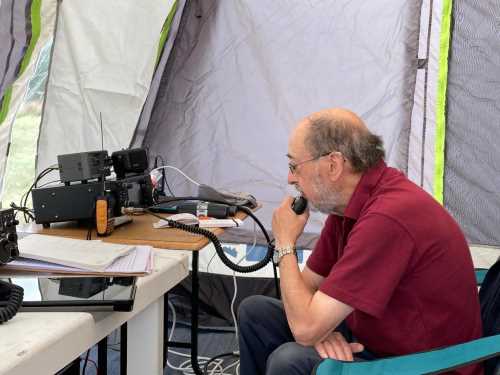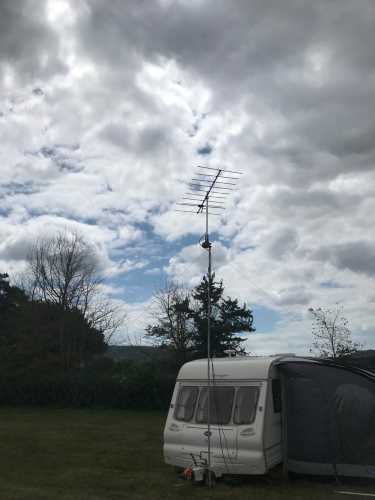Being located in Worthing, on the coastal plain with large chalk hills between here and the rest of the UK, the group had never previously taken part in VHF NFD. Thanks to Bill (G8AQX) obtaining access to a portable location just north of the South Downs at IO90TW and single-handedly planning the equipment and operation, the group was able to have a first attempt at VHF NFD, operating under the callsign M0REG/P.
Bill not only collated all the equipment and antennas, but also supplied the caravan from which the operations would take place. He arrived on the Friday to set up both his caravan and awning from which operations were to take place on the following two days.

By the time Nick (G0PBV) arrived on the Saturday morning to help set up, Bill had already set up the transceivers on tables and readied the cables. Equipment used was IC-7300 for 6m (100W SSB) and 4m (50W SSB), IC-275H for 2m (100W SSB), and FT-726R (G3QUE) for 70cm (10W SSB). Not long after, Mike (G0JXX) was also on hand to help erect the mast and rotator for the 10 ele, 2 m beam and assemble the 6m flowerpot. Bill had suggested that on Day 1 we start on 6m (scheduled session between 2 and 10 pm) and sometime later, in the afternoon, migrate to 2 m; Day 2 would be reserved for 4m (flowerpot antenna) and 70cm (Yagi).
Prior to the start, Mike found the Newfoundland beacon right down in the noise on 6m – quite a surprise, especially with only a flowerpot antenna at around 7-8m AGL!

Mike started the transmitting on 6 m with Bill logging and after he had left later in the afternoon, Nick took over on 2 m. Later in the evening, Paul (G3SXE) joined to add his expertise on 6 m and proved a point that the band itself could be more productive in the evenings than it can sometimes be during the day.

The second day required a change of antennas, which proved something of a challenge, single-handedly for Bill and resulted in a slight modification of one of the 2m Yagi elements! The 2m beam was switched for a 15 element 70cm Yagi.
Bill finally wrapped up the station during the afternoon of the Sunday but had sensibly booked the site for a slightly more relaxed departure on the Monday morning.

For a first time on the NFD, results were satisfying with DX distances worked for 6 m, 2m and 4m; unfortunately, it was hard work on 70cm and no QSO’s were had on this band with 10W.
Total number of contacts were 6m = 16, 4m = 12, 2m = 18, 70cm = 0.
Most notable QSO’s (distance and locator square listed), were:
| Band | Callsign | Distance (km) | Locator |
| 6m | LZ6S | 2131 | KN22pv |
| 6m | IK7EOT | 1797 | JN80pj |
| 6m | LY5OM | 1786 | KO25sj |
| 6m | YU1SDS | 1762 | KN04ok |
| 6m | LY2LW | 1731 | KO26cw |
| 6m | I8QLS | 1586 | JN70cu |
| 6m | 9A1AY | 1457 | JN85qg |
| Band | Callsign | Distance (km) | Locator |
| 4m | G2BQY/P | 155 | IO81rf |
| 4m | G0VHF/P | 155 | JO01pu |
| 4m | G3PYE/P | 145 | JO02ce |
| Band | Callsign | Distance (km) | Locator |
| 2m | GM3AM/P | 507 | JO74wp |
| 2m | MM0CPS/P | 491 | IO84bt |
| 2m | EI9E/P | 476 | IO62om |
| 2m | ON4PRA | 327 | JO20dw |
| 2m | ON4KHG | 307 | JO10xo |

There were also some good learning points from the exercise including:
- Provide sufficient lengths of coaxial cable to reach from antennas to transceivers
- Ensure at least 2 to 3 people are present when changing beams
- Two stations operated simultaneously would ensure a higher QSO rate
- Consider future use of a tilt-over mast
Well done to all who took part and particularly to Bill who did most of the donkey work in preparation for, and closing down of, our first VHF NFD field station! – Nick (G0PBV)